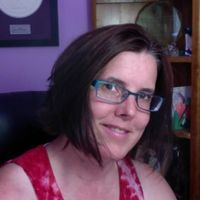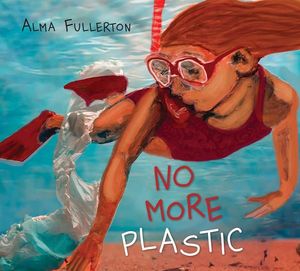Alma Fullerton Uses Literal Plastic Trash to Advocate for a Plastic-Free Future in Her Inspiring New Picture Book
Alma Fullerton's No More Plastic (Pajama Press) goes beyond simply communicating its titular message in words. Instead, Fullerton got down to the nitty gritty and created her illustrations out of literal plastic waste (along with beach sand and moss). These trash-to-treasure collages tell the story of Isley, who is heartbroken when a right whale is beached near her PEI home, starved to death after its stomach filled with plastic ocean waste.
Not content to let the whale have died in vain, Isley challenges herself and the grown ups around her to adopt zero waste lifestyles. But when the enthusiasm of even the well-intentioned begins to wane, Isley is forced to decide what she can do to keep her cause going—and protect both her own future and the future of her beloved ocean-dwelling friends.
No More Plastic is certainly a great tool for discussing the climate crisis with the kids you care about, but it's also a powerful reminder for adult readers. We're excited to welcome Alma to Open Book to tell us about the passion that motivated her to write this important story, as part of our Kids Club series speaking with writers of books for young people.
She tells us about where she found help collecting the plastic that became her artwork, what she wishes people knew about the picture book writing process, and the essential element in crafting a great kids' book that is even more important than a fantastic story.
Open Book:
Tell us about your new book and how it came to be.
Alma Fullerton:
No More Plastic is about a girl in PEI who builds a whale out of plastic as a statement to remind people in her area plastics hurt the environment and animals. I am very passionate of environmental issues and changing our practices to help protect the environment for future generations.
OB:
Is there a message you hope kids might take away from reading your book?
AF:
I would love to see children take action and do their own things to protect our planet.
OB:
Is there a character in your book that you relate to? If so, in what ways are you similar to your character and in what ways are you different?
AF:
Isley is very much like me and my children in the way that she will take action and speak out about what she believes in.
Your CanLit News
Subscribe to Open Book’s newsletter to get local book events, literary content, writing tips, and more in your inbox
OB:
What was the strangest or most memorable moment or experience during the writing process for you?
AF:
The most memorable moment was sharing the illustration process with the children and teachers whom I work with. They are the ones that helped me collect the plastic for the illustrations.
OB:
What do you need in order to write – in terms of space, food, rituals, writing instruments?
AF:
Mostly I need alone time for writing, and for these illustrations I needed the space to set everything up. I use both my computer and notebooks to write and usually have a playlist for each book.
OB:
How do you cope with setbacks or tough points during the writing process? Do you have any strategies that are your go-to responses to difficult points in the process?
AF:
If there are setbacks mentally in my writing process I find clearing my head and reading back helpful to get back into the character’s head and the story. As for other setbacks that are out of my control I’m a go with the flow type of person and a lot of times that means waiting for other people which I’m fine with. But at the same time, I am not afraid to move forward on projects, if people take too many months to get back to me (this generally means over six months). I’m an editor myself so when I take a step back for a while I can usually see where things need fixing and know how to fix them.
OB:
Do you feel like there are any misconceptions about writing for young people? What do you wish people knew about what you do?
AF:
I wish people understood how hard writing picture books is. Most people feel writing picture books is easy because there are so few words. Less words actually means harder, because you have to get the full story and a well rounded character into 500 words. As an editor and mentor I see way too many poorly written picture books and novels. Many writers talk down to children or slap them with an obvious morale. There’s a fine line between getting the message across and being didactic.
OB:
What defines a great book for young readers, in your opinion? Tell us about one or two books you consider to be truly great kids books, whether you read them as a child or an adult.
AF:
A fantastic loveable character for me makes a great book. Even if you have the best plot in the world, if no one can connect with your character they won’t care to follow them through the plot. A reader must connect emotionally with your character. There are really too many great books out there to mention them all, or even a few of my favourites without forgetting to mention some.
OB:
How would you describe the writing community in Canada in terms of authors writing for young people? What strengths and weaknesses do you observe within the community?
AF:
Right now I’m the Regional Advisor of the Society of Children’s Book Writers and Illustrators Canada East chapter so I get to see a lot of the community. I love how we’re like a big family and how everyone supports everyone else. I see authors stepping up to help new writers all the time. We celebrate each other’s wins and cry with their losses.
OB:
How, if at all, does social media feature in your writing process?
AF:
Social media can be a great help with promotion and meeting new writers but I do have a lot of ‘jobs’ and keeping up with it all does take a lot of time.
OB:
What's your favourite part of the life cycle of a book? The inspiration, writing the first draft, revision, the editorial relationship, promotion and discussing the book, or something else altogether? What's the toughest part?
AF:
I love much of the process from research to final edits and promotion and school visits, but my favourite part is somewhere in the middle of the revision process when the character becomes so real you can celebrate with them or cry with them. You want nothing more than to get them what they need to succeed in life. It’s a great feeling too when you get letters from readers telling you your book has changed their lives in someway for the better. That’s why I write. For those kids.
OB:
What are you working on now?
AF:
I tend to work on several things at once.
I just finished the edits on a middle grade novel in verse called Flipping Forward and Twisting Backward, due out with Peachtree Publishing Co. in fall 2022. It’s a fictional story about a girl with a learning disability. Growing up with dyslexia the book is very close to my heart.
I’m also working on two other books about the environment and protecting the planet. One is a middle grade novel in verse and the other is a picture book that’s already written and I’m in the process of completing a dummy for submission.
________________________________________
Alma Fullerton’s free-verse novels for juvenile and young adult readers have earned her multiple nominations and awards, including the Ruth and Sylvia Schwartz Award and the CLA Book of the Year Honour. Her first picture book, A Good Trade, has been a White Ravens Choice, a Bank Street Best Book, and a nominee for the OLA Blue Spruce Award and the Kentucky Bluegrass Awards. In a Cloud of Dust won the Rainforest of Reading Award, was nominated for the OLA Blue Spruce Award, and was a Foreword Magazine Best Children’s Books of Fall 2015 selection. Alma lives in Midland, Ontario.




